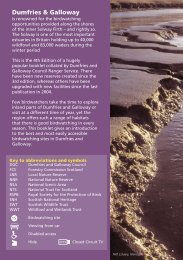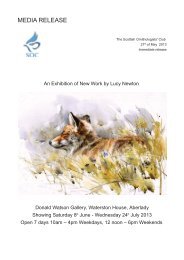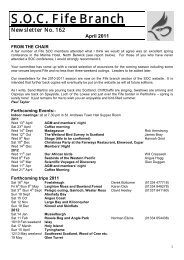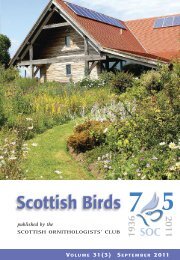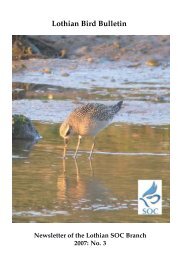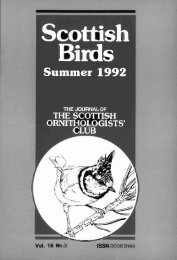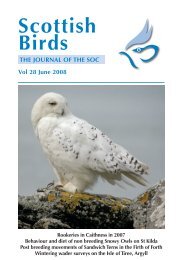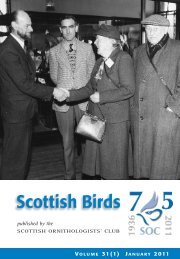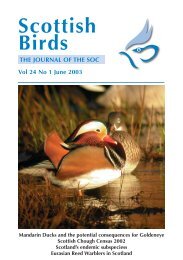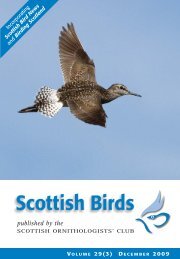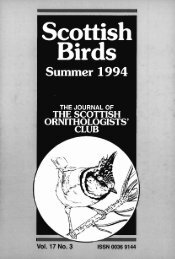V 14 No.4 - The Scottish Ornithologists' Club
V 14 No.4 - The Scottish Ornithologists' Club
V 14 No.4 - The Scottish Ornithologists' Club
You also want an ePaper? Increase the reach of your titles
YUMPU automatically turns print PDFs into web optimized ePapers that Google loves.
1987<br />
Short Notes 209<br />
Short Notes<br />
Golden Eagles attacking deer and sheep<br />
Publication of Graham Rebecca's note on<br />
this topic (SB <strong>14</strong>: 86) resulted in the submission<br />
of several reports of Golden Eagles<br />
attempting to take red deer; these are summarised<br />
below. More recently we received<br />
the following note recording an instance in<br />
which an eagle attacked and killed a sheep.<br />
<strong>The</strong> fact that, despite extensive fieldwork<br />
carried out on this species over many years,<br />
such an incident has not been documented<br />
previously suggests that it is a very exceptional<br />
occurrence. While it would be<br />
undesirable to suppress this record, which<br />
is of scientific interest, it is also important<br />
that it is not taken out of context and<br />
regarded as of major significance. R.H.<br />
Dennis has also pointed out that very<br />
unusual behaviour, such as attacks on dogs<br />
and domestic poultry, has been recorded in<br />
eagles which have escaped or been released<br />
from captivity. <strong>The</strong>re is no suggestion that<br />
the bird referred to in Peter Ewins' note was<br />
other than wild, but the origin of birds<br />
carrying out unprecedented behaviour may<br />
be suspect. Ed.<br />
Eagles and Red Deer<br />
In January 1965 James Wilson was stalking<br />
hinds and calves on Badanloch Estate,<br />
Sutherland, when an eagle stooped and hit<br />
a calf, knocking it over. <strong>The</strong> calf recovered<br />
and rejoined the rest of the stampeding<br />
herd, which swam a burn in full spate. <strong>The</strong><br />
keeper he was accompanying commented<br />
that it took a lot to put deer into nearfreezing<br />
water. On 17 September 1980, near<br />
the east coast of Islay, Keith Verral and a<br />
friend watched a juvenile Golden Eagle<br />
attacking a hind on the fringe of a mixed<br />
herd of deer, landing on her back and gripping<br />
her shoulder and hindquarters. <strong>The</strong><br />
hind dislodged the eagle by throwing back<br />
her head. After several such unsuccessful<br />
attacks, during which the deer were moving<br />
downhill, the eagle gave up. On 20<br />
November 1982, in Glen Clunie (near<br />
Braemar), Ron Youngrnan saw an immature<br />
eagle making repeated dives, with its talons<br />
extended, at a party of four hinds. <strong>The</strong> bird<br />
came to within 4-5 feet of the deer but never<br />
actually struck them. <strong>The</strong>re was heavy snow<br />
cover at the time.<br />
Golden fdgIe attacking and killing sheep<br />
On 27 October 1981 M.W. Richards and I<br />
watched a female Golden Eagle Aquila<br />
chrysaetos attack and kill a fully-grown<br />
Blackface ewe on the west coast of Scotland.<br />
A pair of adult eagles, accompanied by an<br />
immature, were patrolling an open hillside,<br />
on which a loose flock of Blackface ewes<br />
were grazing. <strong>The</strong> female eagle suddenly<br />
stooped from the ridge down towards a<br />
group of about six ewes, which panicked<br />
and ran downhill. All six sheep appeared to<br />
be fully fit adults and there was no indication<br />
that a weak individual had been singled<br />
out. Within a few seconds the eagle had<br />
plunged its talons into the neck of one ewe,<br />
which fell to the ground. <strong>The</strong> eagle retained<br />
its grip on the ewe's neck for the next 20<br />
minutes, despite initially being periodically<br />
tossed around by the spasms of the dying<br />
ewe. When the eagle finally released her grip<br />
she tugged at the fleece a couple of times<br />
before flying c.250 m up the hillside to perch<br />
beside the other two eagles, at which stage<br />
c.50 Hooded Crows Corvus corone moved<br />
in to the carcass. One hour later both adult<br />
eagles were feeding at the carcass, tearing<br />
at skin and flesh, and one remained feeding<br />
until dusk. Two days later three eagles were<br />
again flying over this hillside, the male<br />
displaying along the ridge. <strong>The</strong> sheep carcass<br />
had been removed, presumably by the<br />
shepherd, whose house was only c.500 m<br />
away, and only a few crows and scattered<br />
bits of wool remained.



